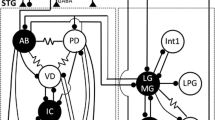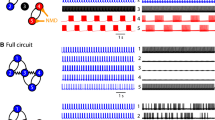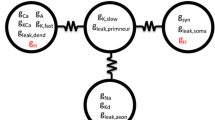Abstract
The sequential firing of neurons in central pattern generators (CPGs) is generally thought to be a result of an interaction between intrinsic cellular and synaptic properties of the component neurons. Due to experimental limitations, it is usually difficult to address the role of each of these properties separately. We have done so by using the crustacean stomatogastric CPG and the dynamic clamp technique to measure how the network responds to the selective modification of an individual important synapse. Our results show that the burst periods and the phase lags between the constrictor (LP) and dilator (PD) neurons across preparations showed significant variability during equivalent experimental manipulations. Despite this variability, the ratio between the change in the burst period and the change in the phase lag between the same neurons was tightly preserved in all preparations, revealing a dynamical invariant in the system. This dynamical invariant was preserved despite the individual variability in the period and phase lag measurements, suggesting a tightly regulated constraint between the parameters of the network.








Similar content being viewed by others
References
Altringham JD, Ellerby DJ (1999) Fish swimming: patterns in muscle function. J Exp Biol 202:3397–3403
Braun G, Mulloney B (1993) Cholinergic modulation of the swimmeret motor system in crayfish. J Neurophysiol 70:2391–2398
Bucher D, Prinz AA, Marder E (2005) Animal-to-animal variability in motor pattern production in adults and during growth. J Neurosci 25:1611–1619
Davis GW (2006) Homeostatic control of neural activity: from phenomenology to molecular design. Annu Rev Neurosci 29:307–323
Delcomyn F (1980) Neural basis of rhythmic behavior in animals. Science 210:492–498
Destexhe A, Mainen ZF, Sejnowski TJ (1994) Synthesis of models for excitable membranes, synaptic transmission and neuromodulation using a common kinetic formalism. J Comput Neurosci 1:195–230
Dicaprio R, Jordan G, Hampton T (1997) Maintenance of motor pattern phase relationships in the ventilatory system of the crab. J Exp Biol 200:963–974
Eisen JS, Marder E (1984) A mechanism for production of phase shifts in a pattern generator. J Neurophysiol 51:1375–1393
Elson RC, Huerta R, Abarbanel HD, Rabinovich MI, Selverston AI (1999) Dynamic control of irregular bursting in an identified neuron of an oscillatory circuit. J Neurophysiol 82:115–122
Graubard K, Raper JA, Hartline DK (1980) Graded synaptic transmission between spiking neurons. Proc Natl Acad Sci USA 77:3733–3735
Harris-Warrick RM, Marder E, Selverston AI, Moulins M (1992) Dynamic biological networks, the stomatogastric nervous system. MIT Press, London
Hooper SL (1997a) Phase maintenance in the pyloric pattern of the lobster (Panulirus interruptus) stomatogastric ganglion. J Comput Neurosci 4:191–205
Hooper SL (1997b) The pyloric pattern of the lobster (Panulirus interruptus) stomatogastric ganglion comprises two phase-maintaining subsets. J Comput Neurosci 4:207–219
Laurent G, Wehr M, Davidowitz H (1996) Temporal representations of odors in an olfactory network. J Neurosci 16:3837–3847
Mamiya A, Nadim F (2004) Dynamic interaction of oscillatory neurons coupled with reciprocally inhibitory synapses acts to stabilize the rhythm period. J Neurosci 24:5140–5150
Marder E, Calabrese RL (1996) Principles of rhythmic motor pattern generation. Physiol Rev 76:687–717
Marder E, Goaillard JM (2006) Variability, compensation and homeostasis in neuron and network function. Nat Rev Neurosci 7:563–574
Marder E, Prinz AA (2002) Modeling stability in neuron and network function: the role of activity in homeostasis. Bioessays 24:1145–1154
Nadim F, Manor Y (2000) The role of short-term synaptic dynamics in motor control. Curr Opin Neurobiol 10:683–690
Nowotny T, Szucs A, Pinto RD, Selverston AI (2006) StdpC: a modern dynamic clamp. J Neurosci Methods 158(2):287–299
Osipova D, Takashima A, Oostenveld R, Fernandez G, Maris E, Jensen O (2006) Theta and gamma oscillations predict encoding and retrieval of declarative memory. J Neurosci 26:7523–7531
Perez-Otano I, Ehlers MD (2005) Homeostatic plasticity and NMDA receptor trafficking. Trends Neurosci 28:229–238
Pinto RD, Elson RC, Szucs A, Rabinovich MI, Selverston AI, Abarbanel HDI (2001) Extended dynamic clamp: controlling up to four neurons using a single desktop computer and interface. J Neurosci Methods 108:39–48
Prinz AA, Abbott LF, Marder E (2004a) The dynamic clamp comes of age. Trends Neurosci 27:218–224
Prinz AA, Bucher D, Marder E (2004b) Similar network activity from disparate circuit parameters. Nat Neurosci 7:1345–1352
Rabbah P, Nadim F (2005) Synaptic dynamics do not determine proper phase of activity in a central pattern generator. J Neurosci 25:11269–11278
Raper JA (1979) Nonimpulsive-mediated synaptic transmission during the generation of a cyclic motor program. Science 205(4403):304–306
Robinson HP, Kawai N (1993) Injection of digitally synthesized synaptic conductance transients to measure the integrative properties of neurons. J Neurosci Methods 49:157–165
Schulz DJ, Goaillard JM, Marder E (2006) Variable channel expression in identified single and electrically coupled neurons in different animals. Nat Neurosci 9:356–362
Selverston AI, Moulins M (1987) The crustacean stomatogastric system. Springer, Berlin
Sharp AA, O’Neil MB, Abbott LF, Marder E (1993a) The dynamic clamp: artificial conductances in biological neurons. Trends Neurosci 16:389–394
Sharp AA, O’Neil MB, Abbott LF, Marder E (1993b) Dynamic clamp: computer-generated conductances in real neurons. J Neurophysiol 69:992–995
Singer W (1993) Synchronization of cortical activity and its putative role in information processing and learning. Annu Rev Physiol 55:349–374
Stemmler M, Koch C (1999) How voltage-dependent conductances can adapt to maximize the information encoded by neuronal firing rate. Nat Neurosci 2:521–527
Thirumalai V, Prinz AA, Johnson CD, Marder E (2006) Red pigment concentrating hormone strongly enhances the strength of the feedback to the pyloric rhythm oscillator but has little effect on pyloric rhythm period. J Neurophysiol 95:1762–1770
Turrigiano GG, Nelson SB (2004) Homeostatic plasticity in the developing nervous system. Nat Rev Neurosci 5: 97–107
Weaver AL, Hooper SL (2003) Follower neurons in lobster (Panulirus interruptus) pyloric network regulate pacemaker period in complementary ways. J Neurophysiol 89:1327–1338
Acknowledgement
This research was supported by NIH grant R01 NS050945.
Author information
Authors and Affiliations
Corresponding author
Rights and permissions
About this article
Cite this article
Reyes, M.B., Huerta, R., Rabinovich, M.I. et al. Artificial synaptic modification reveals a dynamical invariant in the pyloric CPG. Eur J Appl Physiol 102, 667–675 (2008). https://doi.org/10.1007/s00421-007-0635-0
Accepted:
Published:
Issue Date:
DOI: https://doi.org/10.1007/s00421-007-0635-0




